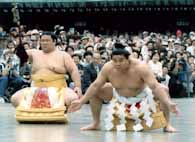|
Science & Technology || Sports & Fashion || Search || Back Numbers
BIG BROTHERS: New Sumo Champion Delights Fans with Speed over Size August 6, 1998  Wakanohana (right) performs a traditional sumo ritual. (Kyodo) Sumo, Japan's oldest professional sport, has seen its popularity on the wane over the last couple of years amidst various scandals and lackluster competition in the ring. The promotion of popular wrestler Wakanohana to sumo's highest rank of yokozuna (grand champion), however, has injected new excitement into the sport and has sumo officials breathing a collective sigh of relief. At 27 years old, the small but feisty Wakanohana has become sumo's third active yokozuna, joining his younger brother Takanohana and Hawaiian-born Akebono, the first foreign-born yokozuna. The sumo world is pinning its hopes on Wakanohana to boost the sport's appeal. Wakanohana Uses Small Size to His Advantage The average size of sumo wrestlers in the top makuuchi division is 153 kilograms and 185 centimeters. At 131 kilograms and 181 centimeters, Wakanohana is quite small. Sumo bouts are fought in a ring measuring 4 meters 55 centimeters (14.9 feet) in diameter. Matches are decided either by driving one's opponent out of the ring or by making a part of his body other than his feet touch the ground. Size and strength are therefore among the most important ingredients for victory, but not necessarily the elements that attract fans. Recently the size of the rikishi (wrestlers) has been increasing while the mobility has declined. As a result, many of today's matches are slower. Perhaps this is why Wakanohana, who relies on superior speed and agile techniques to make up for his lack of size, has long been a fan favorite. Takanohana, who is two years younger than his brother Wakanohana and has won 19 grand tournaments since turning pro in 1992, is already notching a place for himself in sumo history as one of the sport's greatest. Wakanohana's promotion to sumo's pinnacle, which came three and a half years after that of his younger brother, marks the first time two brothers have shared the rank of yokozuna. According to statistics compiled by the Nihon Sumo Kyokai (Japan sumo association), only one in every 310 rikishi make it to yokozuna. From this perspective, two brothers sharing this rank at the same time is in itself quite miraculous. Even for Meals and Baths, Ranking is EverythingMost aspiring rikishi enter the world of sumo upon graduation from middle school. After gaining acceptance to one of about 50 sumo "stables," rikishi live and train communally. Most begin at the lowest rank of jonokuchi and gradually work their way up the lower division ranks of jonidan, sandanme, and makushita. Only those wrestlers who break into the upper divisions--26 in juryo and 40 in makuuchi--receive salaries. During a Grand Sumo Tournament, six of which are held each year in odd-numbered months, juryo and makuuchi wrestlers have one match a day for 15 days. Those who compile eight or more victories ensure themselves of a higher rank for the next tournament. Wrestlers with the rank of ozeki, the next highest after yokozuna, who capture at least two consecutive tournaments have a good shot at promotion to yokozuna; two consecutive records of eight losses or more guarantee a demotion in rank. For yokozuna, the price of losing is even greater. They are looked up to as paragons, and thus there is no demotion. A yokozuna who posts a string of losing records has only one option--retirement. In the world of sumo, rank determines everything. Even outside the ring, in everyday affairs like meals and bathing, higher ranking wrestlers are given priority. Lower ranking wrestlers are assigned all cooking and cleaning chores. They also serve as personal attendants to the sekitori (wrestlers ranked juryo and above). Will the Yokozuna Brothers Save Sumo?Wakanohana and Takanohana are members of the Hanada family, a distinguished name in the sport of sumo. Their uncle was active as yokozuna into the 1960s, and their father, now stable master of the prestigious Futagoyama stable where they train, reached the rank of ozeki during his wrestling career. The brothers created a sensation, dubbed "Waka-Taka fever" by the Japanese press, when they first entered sumo in the early 1990s, and they quickly became national idols. Their rapid success as teenagers, however, also stirred strong envy and resentment among the older rikishi they were rapidly overtaking in the rankings. But like his younger brother, new yokozuna Wakanohana has let nothing come between him and the top. The champion brothers seem ready to take sumo to a new level of popularity.
 Edited by Japan
Echo Inc. based on domestic Japanese news sources. Articles
presented here are offered for reference purposes and do not
necessarily represent the policy or views of the Japanese
Government. Edited by Japan
Echo Inc. based on domestic Japanese news sources. Articles
presented here are offered for reference purposes and do not
necessarily represent the policy or views of the Japanese
Government.
|
